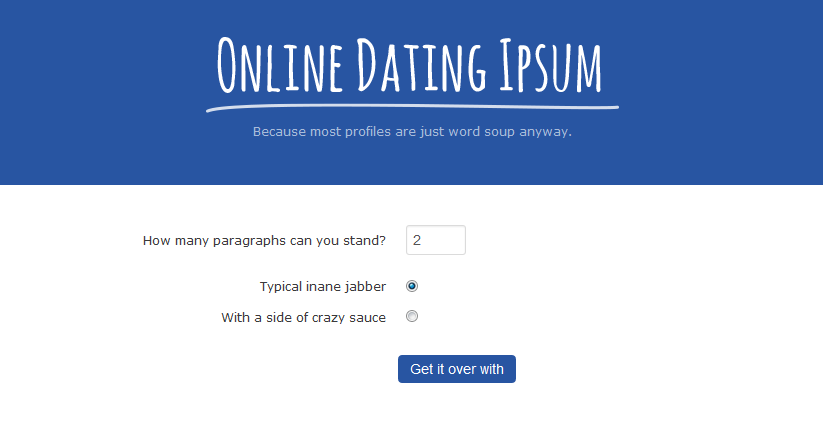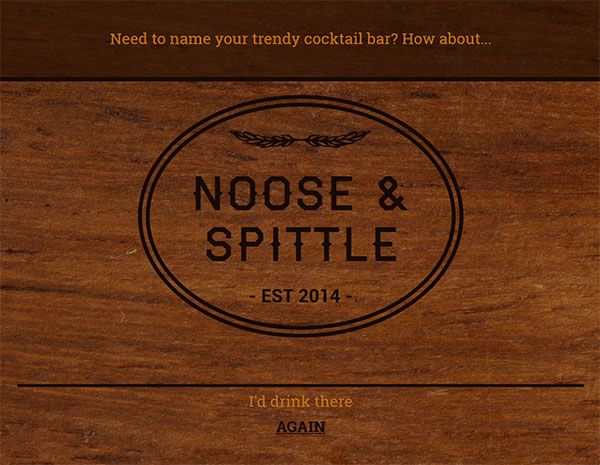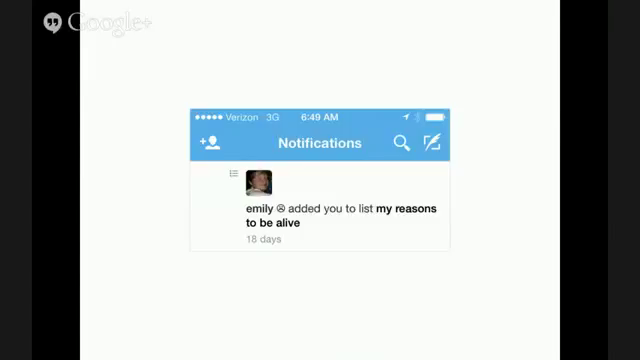I think I’m maybe the first person to talk who doesn’t have a really strong programming background, so go easy on me. Everything I create here today was made after like one web class and I don’t know PHP and blah blah blah. So that said, I’m a graphic designer. So I’m coming to this stuff from a design background.

This is the first thing that I made. I’m just going to go through one or two really brief projects before I start talking about the bot that I’ve made. This is the first sort of generative text project that I made that takes a bunch of commonly-used phrases in OKCupid profiles and strings them together as this sort of lorem ipsum generator thing. It has a very small sample size to pull from so it repeats itself a lot, which I really like because OKCupid dating profiles are horribly boring and repetitive, and everyone’s super-chill and laid back and likes mountain climbing all the time. So here’s another example. You know like Breaking Bad and NPR and Doctor who, like all the time.

I got a little bit of coverage for this, which was cool, so I just kept making things that started as kind of a joke. Another one I did was this thing that names your cocktail bar. There’s really, there’s just like, there’s ten of them. There’s like a Bourbon & Branch, and a Bank & Bourbon, it’s like the same damn bar, so I just started making funny… So it pairs a one-syllable word and a two-syllable word, it just does random things.
But what I’m really here to talk about today was the first bot that I made—the only bot that I’ve made—called The Lonely Project. This is actually how I met Darius, because I did not know how to code this thing or make this thing, and I was Googling tutorials and this is how I got here.
So I’m going to start with why do this project. It got a write-up at this Technically Philly blog in my hometown, and this is how they described it:
https://mobile.twitter.com/TechnicallyPHL/status/514804095795101696
It was the saddest tweet in the world. I was like, “Thanks, guys!” So I Instagrammed it with the #lolsob hashtag. So that was the genesis of this project. I had been through a breakup, and I was sitting awake at the end of the night, and I checked Facebook and Twitter and the news and Reddit and whatever. And I just wasn’t finding what I wanted, which was some way to connect to other people who are sitting there twiddling their thumbs over their phones and feeling kind of depressed and not knowing what to do. So I wanted to make something that was sort of like a landing page for that feeling.
It’s a mobile web site, and what it does is it pulls one random tweet from Twitter at a time from a person who’s saying that they’re lonely, and you have two options. You can either reload it to load another one or you can hit the tweet button and it’ll give you a little bit of an instruction if you’re totally confused about what those buttons mean. But hopefully you get it. Then the check mark shows up when you actually have tweeted to this person. You don’t know who they are. It gives you no handles, no identifying information, no location. All you know is they’re typing in English and that is how they’re feeling at this general moment in time. And then it just sends them this tweet. It’s one tweet over and over again: “Someone over here wanted you to know that you’re not alone.”
So that is the idea and it was a really simple idea. It’s an account that does one thing. And when I first launched it I was really really nervous that people were going to hate it. Because you know, it’s kind of a robot and it’s talking to you in this moment of vulnerability and I thought it was entirely possible that people would freak out at it and be like, “Why is this thing talking to me? You’re not a person. You’re not helping.” But actually I’m kind of happy to say that it’s had really the opposite reaction. So I’m just going to go through a couple of lessons I learned from making this weird thing.
Being vulnerable on the Internet sucks. People have this drive to reach out and talk to other people, but they have a hard time doing it. So I see a lot of tweets that look like this, where it’s people who are sad but they end it with “LOL,” or they end it with a joke like they’re kinda laughing about themselves. A lot of “LOL” tweets, and then a lot of song lyrics, especially this one over and over and over. This is a ten-year old 3 Doors Down song. But it is the most common thing that I see in this feed, it is so funny. So every once in a while this will come up for someone who’s using this web site and the bot will tweet to that person, and then I’ll get a reply that says, “It’s just song lyrics but thank you!” And I’m like, you picked them for a reason, alright? So people have a hard time actually admitting that they feel this way and have a hard time talking about it, and it’s kind of interesting to see the ways that people on Twitter are trying to express that feeling without really expressing it, getting too emotional.

So yeah, it’s a robot but actually people like it. These are some samples of the replies that this account gets. It seems like a lot of young people, honestly. A lot of kids in high school who just really feel alienated and are just on the Internet and want someone to talk to. It gets screenshotted, it gets retweeted a lot, which is really nice to see. I made someone’s birthday, that was cool.

It was like oh Emily, change your little frowny face. And she does, actually. That person changes her face from frowny to happy every day, depending on how she’s feeling. Guess I caught her on a bad day.
Liking it is different from using it. It’s still a very small account. It’s only tweeted 1800 times. This was launched in April [2014]. Most of them are not me at this point, other people are using it. But it only has 137 followers, it’s kind of a nice thing. So when people get tweeted at, I was kinda hoping that they would then go back and find the site and start talking to other people on it, which seems to happen but not at a very high rate. So it’s a really slow-growing account. It goes through bursts of activity and then it’s really slow and then…whatever.
But I think the interaction stats are really interesting so like a third of the time I tweet to somebody, or the account tweets to somebody it gets faves. Which, it’s just remarkable to me that people actually like it enough to throw it a fave even thought it’s someone they don’t know who’s just reading their stuff on a site. But it really does seem to actually help people feel a little bit better.
So, other findings. Justin Bieber. When people are lonely, they try to talk to Justin Bieber. It’s really amazing. So that’s something I see [over it?]. It’s neither here nor there or anywhere, but I just thought it was kind of a funny thing. And it did get a little local press. There’s a picture of my face that local news squished really terribly badly.
So that’s a recap of my bot. If you have any questions I’ll take them.
Audience 1: Does the bot tweet just at the user, or in reply to their lonely tweet?
Lauren: It just tweets at the user, I believe. Yeah, it doesn’t actually reply to that tweet in particular.
Audience 1: What is the timeframe for a tweet being on there to reply to?
Lauren: I think it only loads the last fifty to pick from, so they’re only up for a couple of minutes before you get new content.
Audience 1: So it’s a quick turnaround from tweeting about it to getting a response
Lauren: Yeah, which I think is why people are right there faving, since it happens pretty fast.
Darius Kazemi: I guess it means there’s also a lot of people blogging about how lonely they are.
Lauren: Yeah, constantly. All hours of the day.
Audience 2: How do you pick up lonely tweets? Do you search for…
Lauren: It’s just searching for, I think “I’m lonely” and “I am lonely” and it does a bunch of filtering to rule things out. And it’s not perfect. Once in a while I’ll get someone who’s writing about not being lonely. So hopefully the user on the other end can sort of humanly weed some of those things out. But anyone can use the account, so it will tweet to anyone [inaudible]
Brett O’Connor: Have you ever seen any replies, or has this bot encountered anybody that seem kind of in a dangerous situation or…
Lauren: A couple times, yeah. And I take it over pretty frequently. If someone writes back with a question or wanting a resource, I will if I see it I’ll step in and start talking to that person. It’s been really rare that someone really seems in a very bad place, but it does happen. And the bot itself follows a bunch of mental health resources, so there’s a little bit of an effort to connect people who are really in trouble with better stuff. But yeah, right now sometimes you just talk to me which is really weird.
Darius: What was your experience as a beginner setting this thing up?
Lauren: It’s really hard, guys. I mean you have some great tutorials and that definitely helps, but there were moments where I was asking for PHP help on Twitter. And I got it. It’s really cool that people who are into these kind of things will just help you make stuff. Which is why I really like this community. But I think the barrier to entry here if you don’t code is high.
Ed Summers [from IRC]: Can you talk about connecting people who are tweeting about being lonely, someone asks.
Lauren: That’s sort of clearly like a v2 of this project, and I don’t entirely know what that would look like. Originally I kinda locked it down so that the account was only saying one thing and reaching out in one way because I was worried it would become a weird bullying platform potentially, because it’s really easy to find people who are in a crappy place and just start picking on them. So I didn’t want to relinquish all control of it. But I think there’s definitely a way to do this. I don’t quite know what it is yet.
Darius: Someone just said, “Here’s a comment. This is a great example of a bot not written by a programmer that I would state is one of my favorites overall.”
Lauren: Oh, thanks. It’ll probably break at some point, but it’s fine.
Audience 4: I think they all break.
Lauren: They all do.
Audience 5: I think Tully [Hansen] had mentioned that it’s interesting that it doesn’t really benefit from being followed. So it’s kind of taking all of the initiative and it’s not trying to grandstand or get attention, really.
Lauren: Yeah. You know, people follow it and I’m not exactly sure why because it will probably never talk to them again. Or probably ever say anything that they’ll ever read again because it’s all @-replies. But it’s kinda nice.
Audience 6: I guess if you followed it and it was talking to one of your friends you might notice.
Lauren: That’s true.
Further Reference
A similar project called Cheer Upper was launched in 2015.
Darius Kazemi’s home page for Bot Summit 2014, with YouTube links to individual sessions, and a log of the IRC channel.
